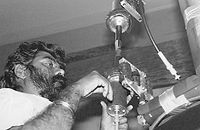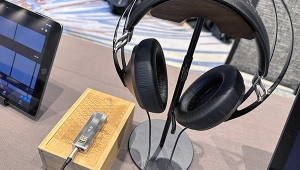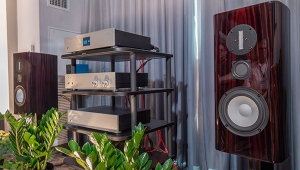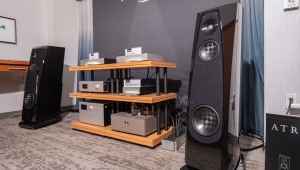| Columns Retired Columns & Blogs |
Poem: Stereophile Cuts an LP The Recording Engineer
The Recording Engineer: John Atkinson
I first met Kavichandran (the name means "Poet of the Moon") Alexander at a CES in the early '80s, when I wandered into the Beveridge room. Probably the hairiest man I had ever seen pressed a cassette of Indian classical music into my hand, insisting that I listen to it. You know how things are, it was several weeks before I got round to playing that cassette, but when I did, it turned out to be a stunningly natural recording. The next CES, therefore, I looked out for this wild-looking Tamil from Ceylon (not Sri Lanka, Kavi insists) and took the time to get better acquainted. Since then I have continued to be impressed by the sound of Kavi's commercial recordings, released on his own Water Lily Acoustics label (footnote 1), so when he phoned to ask if we would be interested in working on a recording project, I jumped at the opportunity.
Talking to Kavi on the phone some weeks after the tapes had been edited, I asked him why he had always been an adherent of the Blumlein microphone technique, where two figure-eight-pattern mics are used vertically coincident in space and angled at 90 degrees:
 Kavi Alexander: I have experimented with MS and ORTF techniques, but my favorite is Blumlein and second the ORTF. The reason I like Blumlein is that you get the best proportions, the sizes of the instruments within the stereo image are the most realistic. The other thing is that the sense of space is more realistic and more believable with Blumlein. It is difficult with this Blumlein technique to get the right balance, however, if you are recording in a church or somewhere with a long reverberation time. But if you have time to fool around, or if you know the location from having made recordings there before, then it's not as time-consuming.
Kavi Alexander: I have experimented with MS and ORTF techniques, but my favorite is Blumlein and second the ORTF. The reason I like Blumlein is that you get the best proportions, the sizes of the instruments within the stereo image are the most realistic. The other thing is that the sense of space is more realistic and more believable with Blumlein. It is difficult with this Blumlein technique to get the right balance, however, if you are recording in a church or somewhere with a long reverberation time. But if you have time to fool around, or if you know the location from having made recordings there before, then it's not as time-consuming.
John Atkinson: I noticed on our sessions that moving the microphones forward or back even 6 inches made a big difference to the amount of reverberation captured.
Alexander: What I normally do is to listen to the live sound on a ladder—a little higher up generally gives a better sound, depending on the music—to find the approximate place where the mics should be placed. I have this gut feeling that Blumlein knew what he was doing, and I really don't think you can improve on what he did. It's a very reassuring feeling.
Atkinson: You're not an advocate of spaced omnis, therefore.
Alexander: No, absolutely not, I've heard pianos that are 30' wide. There is a school that says that you have to use omnis because they are first-order microphones, have better bass, and are less colored, but I don't agree. I've even used B&K measuring microphones, which are supposed to be the flattest, and the results were not in any way comparable with what you can get with a well-placed Blumlein pair. I did once try what is basically a Jürg Jecklin technique, where you space two omnis by 7 or 8", the inter-aural distance, with a baffle in between. That, I guess, is probably the only acceptable spaced-omni technique, but even that I don't think is comparable with Blumlein for replay over loudspeakers rather than headphones.
Atkinson: We ended up recording the piano with the lid on the short stick so that the instrument would not overpower the flute. Did miking the flute and piano present any other problems for the Stereophile sessions?
Alexander: No, because I was able to spend time in the hall [USC's Allan Hancock Foundation Auditorium, which seats around 500 people] before the sessions with my ladder. I was able to determine roughly the location that would give us a decent sound, and from there it was a question of adjusting the mics by a few inches.
Atkinson: Tell me about the tube microphones we used for the Griffes, Schumann, and Prokofiev pieces.
Alexander: The microphone is a custom design by Tim de Paravicini. It uses a Milab dual-rectangular capsule, and we have found that that capsule is very special. The reason Milab made it rectangular was that all normal capsules, being circular like a tambourine, will have a resonant peak that is very often in the midrange. Milab found that by making a rectangular capsule, you broke up that resonance and moved it higher up in frequency where it was less dangerous. It was moved out of the critical midband area. So that capsule is in a class by itself. I was able to get the capsules from the factory in Sweden, then Tim just built the microphones around them.
It's a unique circuit, it doesn't just follow traditional tube microphone circuitry, and the other thing that is very special is the mic's output transformer. The frequency response of the mic is down to 5Hz and on the top it goes to 35kHz, so we have to use that massive stand and try to isolate the mics from footfalls and stuff like that...But I think the real strength of that microphone is its neutrality. If you compare it with the classic tube mics, like the AKG or Neumann, they are definitely far more colored, they romanticize the music, and the two frequency extremes are less good, the bass is softer, more rolled off, and the highs are bright and brittle.
Atkinson: What about the Ampex MR70? I'd never seen one of those before our sessions.
- Log in or register to post comments




































